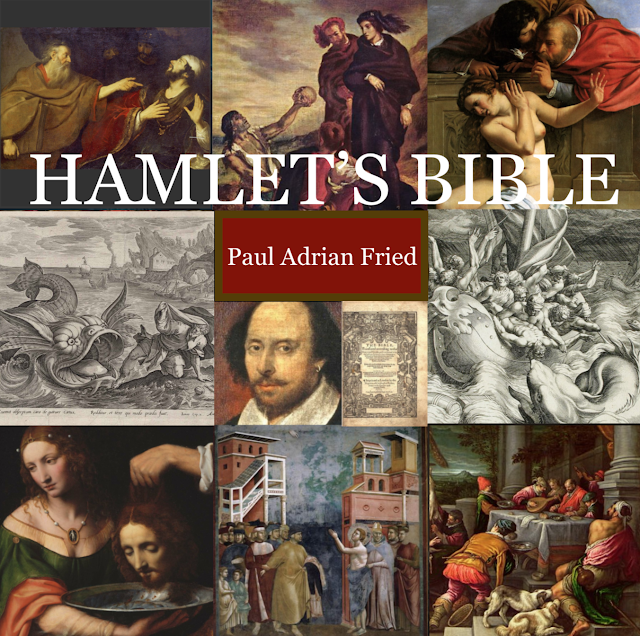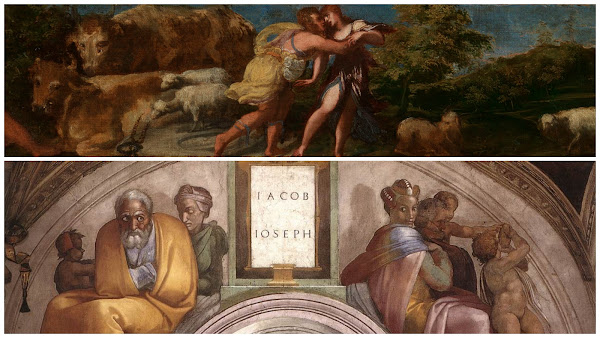“Hoist with his own petard”: Jacob-Hamlet Echoes, part 2
In addition to Laertes’ “double blessing” remark (1.3.58),
which points to the biblical Jacob story
(as noted in a previous post) [1],
note how in both Hamlet and the biblical Jacob tale,
“purposes mistook” fall on the “inventor’s heads” (Horatio in (5.2.426-427)):
What goes around comes around. A perennial theme.
As Shakespeare develops this theme richly, echoing biblical themes, we are right to ask if Shakespeare was influenced by the Jacob story - besides a myriad of others, including biblical teachings. [2]
DECEIVER BECOMES DECEIVED IN THE JACOB TALES (Gen 25-33):
1.a. By pretending to be his brother, Jacob deceives his father to obtain the birthright.
- Later, his father-in-law Laban deceives Jacob on the wedding night, substituting the older sister Leah for the agreed-upon bride of Rachel. [3]
1.b. Jacob who struggles with sibling rivalry is later burdened with two wives, sisters who struggle with sibling-rivalry.
IN HAMLET:
2.a. Hamlet tries to deceive the court, pretending to be crazy.
He is later deceived by Polonius, hiding and spying from behind the arras in Gertrude’s closet(3.4); and by Laertes and Claudius with poison rapier and chalice (5.2).
VICTIM BECOMES VICTIMIZER BECOMES VICTIM:
2.b. Hamlet, who had a father murdered and wanted to avenge his father’s death by killing Claudius,
ends up killing his prospective father-in-law Polonius by accident (3.4),
and then suffers Laertes seeking revenge for his father’s death (5.2).
POETIC JUSTICE
3. Various forms of poetic justice in the Jacob tale are also themes in Hamlet:
Laertes warns Ophelia not to be sexually “prodigal”;
Ophelia warns back: OK, but don’t be a hypocrite. (1.3.40-55)
“’...tis the sport to have the engineer
Hoist with his own petard...” [4] [5]
(3.4.229-230)
“Their defeat
Does by their own insinuation grow.”
(5.2.65-66)
“I am justly killed with mine own treachery.”
(5.2.337)
“He is justly served.
It is a poison tempered by himself.”
(5.2.359-360)
“...purposes mistook
Fall’n on th’ inventors’ heads.”
(5.2.426-427)
The theme of how consequences can fall back on the schemer is present in the Jacob-Rachel tale, and in Hamlet as well. [6]
THESE EXAMPLES ALSO FIND ECHOES in other biblical passages:
- The “second greatest law”: “love your neighbor as yourself” ( Matt 22:35-40).
Treat others as you’d like to be treated; consequences may come back on you.
- They are also linked to Horatio’s allusion to the mote in the eye (1.1.124):
First remove the plank in your own eye before removing the speck from your neighbor’s. Judge yourself first, not others, for you’ll be measured by the same standards you use for others. (Matt 7:1-5)
For the source tales [7], the revenger is more an action-hero in waiting. For Shakespeare, Hamlet is more biblically-influenced and must look in the mirror of his oppressors and, at times, see an image of himself. The Jacob tale was one of Shakespeare's many teachers on this theme.
~~~~~~~
NOTES:
POSTS IN THIS SERIES:
Part 1: Laertes' "double blessing": Echoes of Jacob, Esau, & Rachel in Hamlet - August 2, 2022
https://pauladrianfried.blogspot.com/2022/08/laertes-double-blessing-jacob-essau-and.html
Part 2: “Hoist with his own petard”: Jacob - Hamlet Echoes - September 6, 2022
https://pauladrianfried.blogspot.com/2022/09/hoist-with-his-own-petard-jacob-hamlet.html
Part 3: Marriage & Maternal Approval: Jacob - Hamlet Echoes - September 13, 2022
https://pauladrianfried.blogspot.com/2022/09/marriage-maternal-approval-jacob-hamlet.html
Part 4: Series conclusion: Hamlet & Jacob - September 20, 2022
https://pauladrianfried.blogspot.com/2022/09/series-conclusion-hamlet-jacob.html
~~~~~
NOTES:
[1] See my previous post in this series about Laertes “second blessing” remark as related to the story of Jacob and Essau and their father’s blessings:
https://pauladrianfried.blogspot.com/2022/08/laertes-double-blessing-jacob-essau-and.html
[2] See later comments in this post about “second greatest law” and about “mote” (1.1.124).
[3] This is called “the bed trick” and is used in other stories and plays such as Measure for Measure and All’s Well that Ends Well, with similar deceptions in The Two Noble Kinsmen and Much Ado About Nothing. See the Wikipedia article on “The bed trick”:
https://en.wikipedia.org/wiki/Bed_trick#Renaissance
[4] All Hamlet quotes from the Folger online edition:
https://shakespeare.folger.edu/shakespeares-works/hamlet/entire-play/
[5] The Wikipedia explanation is helpful: ‘"Hoist with his own petard" is a phrase from a speech in William Shakespeare's play Hamlet that has become proverbial. The phrase's meaning is that a bomb-maker is lifted ("hoist") off the ground with his own bomb (a "petard" is a small explosive device), and indicates an ironic reversal, or poetic justice.’
https://en.wikipedia.org/wiki/Hoist_with_his_own_petard
[6] Jesse Cooke recently posted some quotes from Vince Lombardi on LinkedIn, and a particular passage seemed related to these themes of poetic justice:
"Success is based on a spiritual quality; a power to inspire others, sometimes for good, sometimes for evil, sometimes for one’s personal ends, sometimes it can be partially or wholly evil. When it is evil, fortunately, while it may temporarily succeed, it always keeps within itself the seeds of it’s own destruction."
- Vince Lombardi
https://www.linkedin.com/posts/historybuffalonian_52-years-ago-on-september-3-1970-vince-activity-6971573625862684672-YqSo?utm_source=share&utm_medium=member_desktop
[7] The source tales are the Amleth tale from Saxo Grammaticus (manuscript circa 1200, print 1514) and the retelling by Belleforest (in French, 1570).
IMAGES:
Top: Andrea Schiavone (1510–1563), “The Meeting of Jacob and Rachel,” circa 1530 - circa 1560. Royal Collection:
https://www.royalcollection.org.uk/collection/402890/the-meeting-of-jacob-and-rachel
Public domain. Image via WikiMedia:
https://commons.wikimedia.org/wiki/File:Andrea_Schiavone_(c._1500-1563)_-_The_Meeting_of_Jacob_and_Rachel_-_RCIN_402890_-_Royal_Collection.jpg
Bottom:
Michelangelo (1475–1564), “Jacob and Joseph,” fresco, between 1511 and 1512. Photo: Web Gallery of Art. Public domain via Wikimedia:
https://commons.wikimedia.org/wiki/File:Michelangelo,_lunetta,_Jacob_-_Joseph_01.jpg
~~~~~~~~~~~~~~~~~~~~~~~~
Disclaimer: If and when I quote or paraphrase bible passages or mention religion in many of my blog posts, I do not intend to promote any religion over another, nor am I attempting to promote religious belief in general; only to explore how the Bible and religion influenced Shakespeare, his plays, and his age.
~~~~~~~~~~~~~~~~~~~~~~~~
~~~~~~~~~~~~~~~~~~~~~~~~~~~~~~~~~~~~~~
Thanks for reading!
~~~~~~~~~~~~~~~~~~~~~~~~~~~~~~~~~~~~~~
~~~~~~~~~~~~~~~~~~~~~~~~~~~~~~~~~~~~~~
My current project is a book tentatively titled Hamlet’s Bible, about biblical allusions and plot echoes in Shakespeare's Hamlet.
Below is a link to a list of some of my top posts (“greatest hits”), including a description of my book project (last item on the list):
https://pauladrianfried.blogspot.com/2019/12/top-20-hamlet-bible-posts.html
I post every week, so please visit as often as you like and consider subscribing.
To find the subscribe button, see the = drop-down menu with three lines in the upper left.

which points to the biblical Jacob story
(as noted in a previous post) [1],
note how in both Hamlet and the biblical Jacob tale,
“purposes mistook” fall on the “inventor’s heads” (Horatio in (5.2.426-427)):
What goes around comes around. A perennial theme.
As Shakespeare develops this theme richly, echoing biblical themes, we are right to ask if Shakespeare was influenced by the Jacob story - besides a myriad of others, including biblical teachings. [2]
DECEIVER BECOMES DECEIVED IN THE JACOB TALES (Gen 25-33):
1.a. By pretending to be his brother, Jacob deceives his father to obtain the birthright.
- Later, his father-in-law Laban deceives Jacob on the wedding night, substituting the older sister Leah for the agreed-upon bride of Rachel. [3]
1.b. Jacob who struggles with sibling rivalry is later burdened with two wives, sisters who struggle with sibling-rivalry.
IN HAMLET:
2.a. Hamlet tries to deceive the court, pretending to be crazy.
He is later deceived by Polonius, hiding and spying from behind the arras in Gertrude’s closet(3.4); and by Laertes and Claudius with poison rapier and chalice (5.2).
VICTIM BECOMES VICTIMIZER BECOMES VICTIM:
2.b. Hamlet, who had a father murdered and wanted to avenge his father’s death by killing Claudius,
ends up killing his prospective father-in-law Polonius by accident (3.4),
and then suffers Laertes seeking revenge for his father’s death (5.2).
POETIC JUSTICE
3. Various forms of poetic justice in the Jacob tale are also themes in Hamlet:
Laertes warns Ophelia not to be sexually “prodigal”;
Ophelia warns back: OK, but don’t be a hypocrite. (1.3.40-55)
“’...tis the sport to have the engineer
Hoist with his own petard...” [4] [5]
(3.4.229-230)
“Their defeat
Does by their own insinuation grow.”
(5.2.65-66)
“I am justly killed with mine own treachery.”
(5.2.337)
“He is justly served.
It is a poison tempered by himself.”
(5.2.359-360)
“...purposes mistook
Fall’n on th’ inventors’ heads.”
(5.2.426-427)
The theme of how consequences can fall back on the schemer is present in the Jacob-Rachel tale, and in Hamlet as well. [6]
THESE EXAMPLES ALSO FIND ECHOES in other biblical passages:
- The “second greatest law”: “love your neighbor as yourself” ( Matt 22:35-40).
Treat others as you’d like to be treated; consequences may come back on you.
- They are also linked to Horatio’s allusion to the mote in the eye (1.1.124):
First remove the plank in your own eye before removing the speck from your neighbor’s. Judge yourself first, not others, for you’ll be measured by the same standards you use for others. (Matt 7:1-5)
For the source tales [7], the revenger is more an action-hero in waiting. For Shakespeare, Hamlet is more biblically-influenced and must look in the mirror of his oppressors and, at times, see an image of himself. The Jacob tale was one of Shakespeare's many teachers on this theme.
~~~~~~~
NOTES:
POSTS IN THIS SERIES:
Part 1: Laertes' "double blessing": Echoes of Jacob, Esau, & Rachel in Hamlet - August 2, 2022
https://pauladrianfried.blogspot.com/2022/08/laertes-double-blessing-jacob-essau-and.html
Part 2: “Hoist with his own petard”: Jacob - Hamlet Echoes - September 6, 2022
https://pauladrianfried.blogspot.com/2022/09/hoist-with-his-own-petard-jacob-hamlet.html
Part 3: Marriage & Maternal Approval: Jacob - Hamlet Echoes - September 13, 2022
https://pauladrianfried.blogspot.com/2022/09/marriage-maternal-approval-jacob-hamlet.html
Part 4: Series conclusion: Hamlet & Jacob - September 20, 2022
https://pauladrianfried.blogspot.com/2022/09/series-conclusion-hamlet-jacob.html
~~~~~
NOTES:
[1] See my previous post in this series about Laertes “second blessing” remark as related to the story of Jacob and Essau and their father’s blessings:
https://pauladrianfried.blogspot.com/2022/08/laertes-double-blessing-jacob-essau-and.html
[2] See later comments in this post about “second greatest law” and about “mote” (1.1.124).
[3] This is called “the bed trick” and is used in other stories and plays such as Measure for Measure and All’s Well that Ends Well, with similar deceptions in The Two Noble Kinsmen and Much Ado About Nothing. See the Wikipedia article on “The bed trick”:
https://en.wikipedia.org/wiki/Bed_trick#Renaissance
[4] All Hamlet quotes from the Folger online edition:
https://shakespeare.folger.edu/shakespeares-works/hamlet/entire-play/
[5] The Wikipedia explanation is helpful: ‘"Hoist with his own petard" is a phrase from a speech in William Shakespeare's play Hamlet that has become proverbial. The phrase's meaning is that a bomb-maker is lifted ("hoist") off the ground with his own bomb (a "petard" is a small explosive device), and indicates an ironic reversal, or poetic justice.’
https://en.wikipedia.org/wiki/Hoist_with_his_own_petard
[6] Jesse Cooke recently posted some quotes from Vince Lombardi on LinkedIn, and a particular passage seemed related to these themes of poetic justice:
"Success is based on a spiritual quality; a power to inspire others, sometimes for good, sometimes for evil, sometimes for one’s personal ends, sometimes it can be partially or wholly evil. When it is evil, fortunately, while it may temporarily succeed, it always keeps within itself the seeds of it’s own destruction."
- Vince Lombardi
https://www.linkedin.com/posts/historybuffalonian_52-years-ago-on-september-3-1970-vince-activity-6971573625862684672-YqSo?utm_source=share&utm_medium=member_desktop
[7] The source tales are the Amleth tale from Saxo Grammaticus (manuscript circa 1200, print 1514) and the retelling by Belleforest (in French, 1570).
IMAGES:
Top: Andrea Schiavone (1510–1563), “The Meeting of Jacob and Rachel,” circa 1530 - circa 1560. Royal Collection:
https://www.royalcollection.org.uk/collection/402890/the-meeting-of-jacob-and-rachel
Public domain. Image via WikiMedia:
https://commons.wikimedia.org/wiki/File:Andrea_Schiavone_(c._1500-1563)_-_The_Meeting_of_Jacob_and_Rachel_-_RCIN_402890_-_Royal_Collection.jpg
Bottom:
Michelangelo (1475–1564), “Jacob and Joseph,” fresco, between 1511 and 1512. Photo: Web Gallery of Art. Public domain via Wikimedia:
https://commons.wikimedia.org/wiki/File:Michelangelo,_lunetta,_Jacob_-_Joseph_01.jpg
~~~~~~~~~~~~~~~~~~~~~~~~
Disclaimer: If and when I quote or paraphrase bible passages or mention religion in many of my blog posts, I do not intend to promote any religion over another, nor am I attempting to promote religious belief in general; only to explore how the Bible and religion influenced Shakespeare, his plays, and his age.
~~~~~~~~~~~~~~~~~~~~~~~~
~~~~~~~~~~~~~~~~~~~~~~~~~~~~~~~~~~~~~~
Thanks for reading!
~~~~~~~~~~~~~~~~~~~~~~~~~~~~~~~~~~~~~~
~~~~~~~~~~~~~~~~~~~~~~~~~~~~~~~~~~~~~~
My current project is a book tentatively titled Hamlet’s Bible, about biblical allusions and plot echoes in Shakespeare's Hamlet.
Below is a link to a list of some of my top posts (“greatest hits”), including a description of my book project (last item on the list):
https://pauladrianfried.blogspot.com/2019/12/top-20-hamlet-bible-posts.html
I post every week, so please visit as often as you like and consider subscribing.
To find the subscribe button, see the = drop-down menu with three lines in the upper left.



Comments
Post a Comment